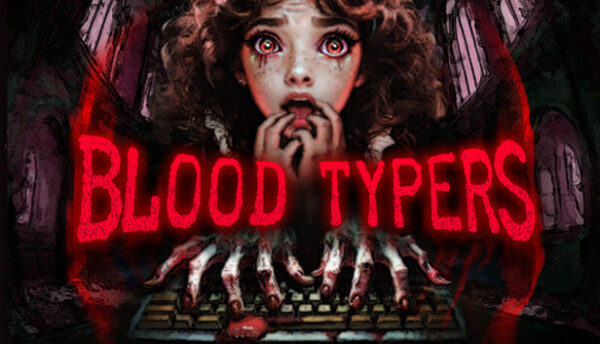Guest Review By FKAGundam
Blood Typers :
When it comes to typing-based games, like Blood Typers, the experience is almost dependent on the player’s efficiency in words per minute. Although video game mastery varies from person to person, this mechanic is arguably more welcoming than picking up a controller or using the mouse and keyboard in tandem. Though it may seem unconventional for a video game to center their game on a skill not often associated with gaming, like words per minute, there’s an element of intrigue that overlaps with the novelty of applying said skill.
Mechanics:
In Blood Typers, navigation revolves around typing words, sometimes as short as two letters, combat consists of typing three words in succession, which vary in length, and healing centers around grabbing sandwiches, bread, blue cheese, or meat. The bulk of the game revolves about navigating levels, called scenarios, and surviving enemy attacks. Some levels involve navigating two-story buildings, which feature the option to either jump towards a connected platform, by pressing the corresponding key at the specific time, or the option to climb up or down a ladder.

Blood Typers features eight playable characters, each with different skills, called perks, and parameters. The only similarity between the characters is that they all start with a steel pipe in their inventory, which is the only melee weapon in the game currently. As far as advantages and disadvantages go, the perks from each character tend to take precedence over their corresponding parameters, which health, agility, violence, and handiness. Regardless, success relies solely on how fast you can type.
Gameplay:
Bloody Typers has five difficulties the player can choose from. The player can decide the difficulty of the game, and the difficulty of the typing independent from the gameplay difficulty, meaning they could temper the experience as they see fit. As expected, speed is perhaps the most important parameter to wield in this game. Blood Typers consists of navigating the scenario, finding five VHS tapes, storing them on an old-fashioned television in exchange for an elevator module, and then installing the module on the at the starting point. Throughout the game, the player encounters two computer stations that must be turned on and can be used as storage. These computers also serve as a “safety on/off” mechanic that removes walls from previously inaccessible items, and ladders.

The enemies in Blood Typers are often in random areas, however, a mechanic of the game is a meter that triggers hordes of enemies to your location. The meter grows over time, and once it’s full, the enemies will converge on your location and it’s a matter of just how fast you can type. After surviving the onslaught, the meter resets and the cycle begins once again.
As previously mentioned, the player can wield the steel pipe to swing at the zombie after a successful word input. Other options for combat are a submachine gun, a magnum, a shotgun, and a flame thrower. Like other survivor horror games, ammunition is not infinite so searching for ammo and managing it throughout contributes to the experience.
The map feature is available at the beginning of each scenario. Since not every scenario is the same, some can include two stories, having the map helps keeping track of where items are, including saving points and computer terminals. Throughout the game, the player can pinpoint where food, weapons, ammo and key items are located. An interesting feature in Blood Typers is that the spot where items are found also serves as placeholders, meaning you can pick up an item and in that same spot place anything in your inventory.

Another interesting feature in Blood Typers is the checkpoint mechanic, which requires finding a film reel and storing it in a filming camera by typing “type here to checkpoint”. While playing, there’ll be up to two reels in the scenario, the player can then decide to insert them into the filming camera and save the game progress up until that point. One thing I noticed while interacting with the saving mechanic is that the enemy meter will jump in percentage. This meter spike is significantly increased in the event of defeat, or “cancelled” as Blood Typers spells it out.
Once the player gathers all five VHS tapes, inserts them on the television, a spectral arm will hand over an elevator module, which the player must grab to complete the scenario. At this point, the enemy meter is perpetually maxed out, and the player must navigate their way back to the starting point while surviving the never-ending enemy waves.
My only issue with gameplay is that the game never pauses, akin to Dark Souls.
Graphics:
Blood Typers has a polished, 3D polygon appearance to it, similar to PS2 titles like Jak and Daxter, Spyro, and Fable. The charm from this era of video games does tend to take away from the horror aspect, but despite that, the possibility of jump scares and surprises still exists.

The only criticism I discovered was enemies clipping through a table as it makes its way to you, as well as the character clipping through the same table as you engage in combat. Other than this, I enjoyed the environment looking like a slightly polished Silent Hill area, the game’s graphics are one of the positives from the game.
Conclusion:
In closing, Bloody Typers is a unique game that blends skill and survival and invites anyone curious enough to show off their typing speed. Unlike other horror survival franchises like Resident Evil, Silent Hill, Fatal Frame, or Clock Tower, speed takes precedence over strategy, patience, or stealth. Although not the first or most popular typing video game, Bloody Typers does an excellent job at humbling your typing skills, welcoming in curious gamers, and even non-gamers.
Disclaimer: A review key was provided

